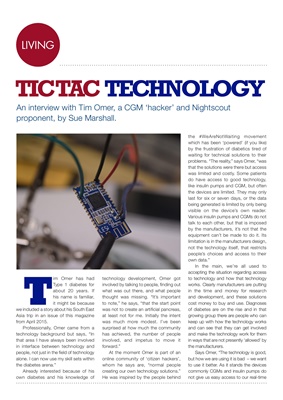
LIVINGLIVING
TIC TAK TECHNOLOGY
An interview with Tim Omer, a CGM 'hacker' and Nightscout
proponent, by Sue Marshall.
T
im Omer has had
Type 1 diabetes for
about 20 years. If
his name is familiar,
it might be because
we included a story about his South East
Asia trip in an issue of this magazine
from April 2015.
Professionally, Omer came from a
technology background but says, "In
that area I have always been involved
in interface between technology and
people, not just in the field of technology
alone. I can now use my skill sets within
the diabetes arena."
Already interested because of his
own diabetes and his knowledge of
technology development, Omer got
involved by talking to people, finding out
what was out there, and what people
thought was missing. "It's important
to note," he says, "that the start point
was not to create an artificial pancreas,
at least not for me. Initially the intent
was much more modest. I've been
surprised at how much the community
has achieved, the number of people
involved, and impetus to move it
forward."
At the moment Omer is part of an
online community of 'citizen hackers',
whom he says are, "normal people
creating our own technology solutions."
He was inspired by the people behind
the #WeAreNotWaiting movement
which has been 'powered' (if you like)
by the frustration of diabetics tired of
waiting for technical solutions to their
problems. "The reality," says Omer, "was
that the solutions were there but access
was limited and costly. Some patients
do have access to good technology,
like insulin pumps and CGM, but often
the devices are limited. They may only
last for six or seven days, or the data
being generated is limited by only being
visible on the device's own reader.
Various insulin pumps and CGMs do not
talk to each other, but that is imposed
by the manufacturers, it's not that the
equipment can't be made to do it. Its
limitation is in the manufacturers design,
not the technology itself, that restricts
people's choices and access to their
own data."
In the main, we're all used to
accepting the situation regarding access
to technology and how that technology
works. Clearly manufacturers are putting
in the time and money for research
and development, and these solutions
cost money to buy and use. Diagnoses
of diabetes are on the rise and in that
growing group there are people who can
keep up with how the technology works
and can see that they can get involved
and make the technology work for them
in ways that are not presently 'allowed' by
the manufacturers.
Says Omer, "The technology is good,
but how we are using it is bad - we want
to use it better. As it stands the devices
commonly CGMs and insulin pumps do
not give us easy access to our real-time